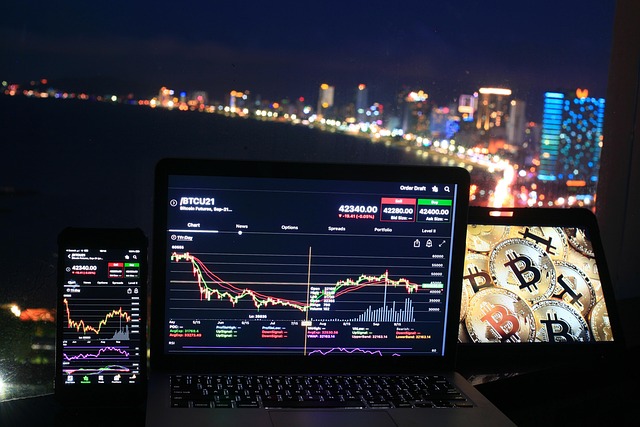Guide to Crypto Market Maker Companies in 2025
Author: Jameson Richman Expert
Published On: 2025-10-22
Prepared by Jameson Richman and our team of experts with over a decade of experience in cryptocurrency and digital asset analysis. Learn more about us.
Crypto market maker companies are the backbone of liquid, efficient cryptocurrency markets. This comprehensive guide explains what they are, how they operate, why they matter in 2025, how to choose and measure them, and the risks and regulatory considerations you must know. Whether you are an exchange operator, a token issuer, or a professional trader, this article offers practical, SEO-optimized guidance and resources to help you evaluate market makers and improve trading outcomes.

What are crypto market maker companies?
Crypto market maker companies are specialized firms (or internal desks of exchanges) that continuously provide buy and sell orders for digital assets to ensure market liquidity and narrower spreads. Like traditional market makers, they stand ready to buy or sell at quoted prices, earn the bid-ask spread and/or rebate fees, and manage inventory and risk through sophisticated algorithms and capital allocation.
Market makers increase price discovery efficiency, reduce slippage for large orders, and enable healthier order books. They operate across centralized exchanges (CEXs), decentralized exchanges (DEXs), and OTC markets, and they increasingly integrate cross‑chain liquidity solutions in 2025.
How crypto market makers operate
Core functions
- Quote provision: Continuously post bid and ask prices to create two-sided markets.
- Inventory management: Balance holdings to control exposure to price moves.
- Risk management: Use hedging, statistical models, and stop limits to limit losses.
- Arbitrage: Exploit price differences across exchanges or instruments to keep markets aligned.
- Liquidity routing: Route orders across venues to maximize fill rates and minimize slippage.
Technology stack
Modern market makers employ low-latency trading engines, colocated servers, robust APIs, and machine-learning models that adapt quotes to market conditions. They often integrate with exchange matching engines and order books via FIX or REST/WebSocket APIs. For DEX activity, they utilize smart contracts, automated market maker (AMM) strategies, and cross-chain bridges.
Examples of algorithmic strategies
- Quote-based strategies (spread maintenance)
- Statistical arbitrage across pairs and venues
- VWAP/TWAP execution for hedging
- Market microstructure optimization (order-slicing, priority placement)
Why crypto market maker companies matter in 2025
As crypto markets mature, market makers deliver tangible benefits:
- Reduced spreads: Narrower bid-ask spreads lower trading costs for retail and institutional traders.
- Improved depth: Deeper books allow larger orders without causing dramatic price moves.
- Better price discovery: Consistent two-sided quotes generate reliable market signals.
- Onboarding for new tokens: Market makers help projects launch with initial liquidity allocation and structured programs.
For example, liquidity provided by market makers can affect token performance and accessibility—read about Ether’s role and outlook in 2025 for context on how market-making interacts with major assets: What is Ether in Blockchain and Its Future in 2025.

Types of market makers
- In-house exchange market making: Large exchanges often operate proprietary market-making desks to support listed pairs.
- Third-party market maker firms: Independent companies that provide services to exchanges and token issuers.
- HFT/quantitative liquidity providers: High-frequency trading shops that focus on ultra-low-latency execution.
- Decentralized liquidity providers: Entities supplying liquidity to AMMs on DEXs and cross-chain pools.
- OTC desks and institutional LPs: Provide bespoke liquidity and block trading solutions off-exchange.
How to choose a crypto market maker company (Checklist for 2025)
Choosing the right market maker is crucial. Use this checklist during selection, contract negotiation, and onboarding.
- Track record & reputation: Ask for verifiable historical performance, references from exchanges and token issuers, and evidence of regulatory compliance.
- Technology & connectivity: Confirm API standards (FIX/REST/WebSocket), latency guarantees, colocation options, and DEX/bridge integrations.
- Coverage & pair expertise: Ensure the firm covers the exchanges and pairs you need (spot, perpetuals, futures) and understands your tokenomics.
- Risk management & controls: Review hedging strategies, stop limits, inventory thresholds, and disaster recovery plans.
- Reporting & transparency: Define KPIs, cadence for trading reports, fees, rebates, and SLA terms.
- Regulatory stance: Confirm compliance in relevant jurisdictions, AML/KYC processes, and willingness to support audits.
- Cost structure: Compare retainer vs. profit-sharing models, rebates, and hidden costs like exchange fees.
- Onboarding timeline: Understand time to live, required capital, and integration testing windows.
Red flags
- Unwillingness to provide references or audited performance data
- Lack of clear compliance or AML practices
- Opaque fee structures or ambiguous KPIs
- Poor disaster recovery or no colocation/latency plans
Performance metrics you must monitor
Agree on objective metrics and monitor them continuously:
- Average spread: Time-weighted average bid-ask spread for the pair.
- Depth at N levels: Volume available within X% of mid-price (e.g., 0.5%).
- Fill rate: Percentage of orders filled at quoted prices.
- Slippage improvement: Difference between pre- and post-implementation slippage for sample orders (VWAP or TWAP)
- Time-to-quote/requote latency: Average latency to update quotes in volatile markets.
- Inventory turnover: How often position rebalances occur to manage exposure.
For measuring slippage and VWAP improvements, use sample order simulations across multiple liquidity conditions (normal, high volatility, low volume). Track and compare metrics before and after engaging a market maker.

Onboarding process — a typical workflow
- Initial discovery: Define objectives (narrow spreads, token listing support, OTC liquidity).
- Due diligence: Legal, compliance, and financial checks on both sides.
- Technical integration: API keys, environment setup, colocation options, and sandbox testing.
- Parameter tuning: Define spreads, inventory limits, and hedging rules.
- Pilot period: Short-term engagement to measure KPIs and adjust strategy.
- Full deployment: Continuous monitoring, monthly/quarterly reviews, and SLA enforcement.
Costs and pricing models
Common commercial models include:
- Flat monthly retainer: Fixed fee for services, often combined with a minimum capital requirement.
- Profit share or performance fee: Percentage of net trading profits or spread capture.
- Hybrid: Lower retainer plus performance incentives and reimbursement of exchange fees.
- Rebate-based: Market maker captures exchange rebates depending on maker/taker status.
Negotiate transparent SLAs that define whether compensation is based on uptime, spread targets, or liquidity depth metrics to align incentives.
Regulatory and compliance considerations in 2025
Regulation continues to evolve, and market makers must operate with strong compliance frameworks:
- Know Your Customer (KYC) and Anti-Money Laundering (AML) rules across jurisdictions.
- Licensing requirements for market-making activities in some jurisdictions (e.g., EU, Singapore, U.S.).
- Rules against market manipulation—firms must avoid misleading quote-stuffing or wash trading.
Refer to authoritative resources for regulatory guidance; for example, the SEC provides investor information and notices related to market conduct (see the SEC’s investor education pages). For an overview of market makers in finance, consult the Wikipedia entry on Market maker and the article on Liquidity (finance).

Risks and common pitfalls
- Counterparty risk: Especially relevant for OTC or non-custodial arrangements.
- Technology risk: Outages, latency spikes, or software bugs can cause severe losses.
- Market risk: Fast price moves can produce inventory losses if hedging fails.
- Regulatory risk: Changes in law may require sudden shifts in operations or licensing.
- Conflict of interest: Market makers that are also exchanges or trading firms must manage potential conflicts transparently.
Market making on different venues: CEX vs DEX vs Futures
Each venue type requires different expertise:
- CEX market making: Relies on exchange APIs, rebates, and order book quoting. Requires strong relationships with exchange operators.
- DEX liquidity provision: Uses AMMs, concentrated liquidity (Uniswap v3), and smart contract interactions—requires on-chain monitoring and gas optimization.
- Futures & perpetual markets: Include funding rate dynamics, margin, and cross-margin implications. Futures market making often needs roll and basis strategies to hedge spot exposure—see comparative analysis on whether futures trading is harder than stocks in 2025 for more context.
Case studies and practical examples
Example 1: New token launch
A blockchain project launching an ERC-20 token engaged a third-party market maker to ensure initial liquidity on multiple CEXs and DEXs. The market maker provided a multi-week program that included seeding order books, establishing a minimum depth, and offering promotional fees to encourage volume. After the pilot, spreads tightened by 60% and the token's VWAP volatility decreased, improving institutional interest.
See the projects’ market context and token-specific dynamics by reviewing targeted analyses such as How does XRP price increase? Key drivers and outlook.
Example 2: Ether liquidity management
Ether remains a core liquidity anchor in many pairs. Market makers that hedge ETH exposure across spot and derivatives platforms reduce basis risk and ensure consistent quotes. For reading on Ether’s market role and outlook, consult What is Ether in Blockchain and Its Future in 2025.
Example 3: Educational resources and trader onboarding
Education for in-house teams and token projects matters. Practical resources—like exchange trading guides and downloadable PDFs—help internal traders understand order book mechanics and market maker interactions. For instance, Binance provides trading guides and books (example resource for Pakistani traders: Binance trading book PDF in Urdu — an in-depth guide for crypto traders) that can accelerate onboarding.

DIY liquidity vs hiring a professional market maker
Smaller projects sometimes attempt DIY liquidity using internal teams or external community incentives. Pros and cons:
- DIY pros: Lower costs, direct control, community engagement.
- DIY cons: Risk of inadequate depth, governance challenges, and higher implementation complexity.
- Hiring pros: Access to capital, institutional-grade tech, faster time-to-market, and measurable KPIs.
- Hiring cons: Cost, dependency on third-party, and need for rigorous contract terms.
For many medium-to-large token issuers, engaging experienced market maker companies is the optimal path to sustainable liquidity.
Best practices for exchanges and token issuers
- Define clear liquidity objectives (spread, depth, pair coverage) before negotiations.
- Request trial periods with defined KPIs and exit clauses.
- Ensure contractual transparency on fees, rebates, and AML/KYC responsibilities.
- Deploy multi-venue strategies to avoid single-point-of-failure liquidity issues.
- Monitor real-time metrics and require daily/weekly reporting during the initial months.
Trends shaping market making in 2025
Key developments to watch:
- AI-driven quoting: Machine-learning models adapt quotes to microstructure shifts and new token behavior.
- Cross-chain and liquidity aggregation: Smart routers and bridges will better align liquidity across chains, making single-venue depth less critical.
- MEV and front-running mitigation: Market makers and exchanges adopt solutions to reduce miner/validator extractable value and protect liquidity providers.
- Regulatory clarity: As jurisdictions finalize frameworks (e.g., Europe’s market in crypto-assets regulations), compliant market-making will become a competitive advantage.

Practical steps to evaluate a market maker (Due diligence checklist)
When you speak to candidate firms, ask for the following documents and details:
- Proof of regulatory registration or explanation of legal jurisdiction
- Audited P&L snapshots or anonymized performance reports
- Technical architecture and API documentation
- Disaster recovery and business continuity plans
- Sample contract and SLA templates
- References from past clients, exchanges, and token projects
Where traders can access markets (recommended exchange links)
To experience liquidity improvements and practice market strategies, professional traders and projects can open accounts on major exchanges. Below are common platforms with account registration links (affiliate):
- Open a Binance account — global spot and derivatives liquid markets.
- Register on MEXC — wide altcoin coverage and promotional liquidity programs.
- Create a Bitget account — futures liquidity and copy-trading features.
- Join Bybit — strong derivatives liquidity and maker incentives.
Further reading and resources
To deepen your understanding of market microstructure, liquidity, and trading tactics, consult these authoritative resources:
- Market maker (Wikipedia) — overview of market maker roles in finance.
- Liquidity (finance) (Wikipedia) — foundational concepts about market liquidity.
- U.S. SEC Investor Education — regulatory information relevant to market conduct.
For market-specific analyses and educational materials, these practical articles and guides can be helpful:
- Ether’s role and outlook in 2025 — useful when planning ETH-paired liquidity strategies.
- XRP price drivers — shows how fundamental drivers affect token liquidity needs.
- Binance trading guide PDF — practical trader education useful for teams working with market makers.
- Futures vs stocks complexity analysis — helpful when deciding whether to include futures market making in scope.

Sample SLA items to include in contracts
When contracting a market maker, require a Service-Level Agreement (SLA) that includes measurable commitments. Sample items:
- Target average spread (e.g., < 0.5% for main pairs) and how it's measured
- Minimum order book depth at defined price bands
- Maximum time-to-quote latency and uptime percentage
- Report cadence (daily execution reports, monthly KPI reviews)
- Termination clauses tied to SLA breaches and remediation timelines
- Audit rights and access to anonymized trade logs for verification
Final recommendations
Crypto market maker companies play a strategic role for exchanges, tokens, and professional traders in 2025. Choose partners with proven tech stacks, transparent reporting, and clear compliance practices. Use objective KPIs and pilot periods to validate performance before committing long-term capital or strategic dependency.
For traders seeking immediate access to liquid markets to practice strategies or test market responses, consider opening accounts on major exchanges (links above). For teams launching tokens, pair market-making engagements with clear on-chain liquidity mechanisms and community incentives to build durable ecosystems.
If you want a tailored shortlist of market maker companies based on your jurisdiction, token type, and budget, tell me your region and objectives and I’ll produce a prioritized vendor list and a sample SLA tailored to your needs.